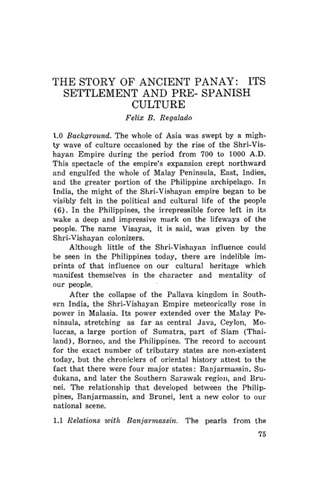The story of ancient Panay: Its settlement and pre-Spanish culture
| dc.contributor.author | Regalado, Felix B. | |
| dc.date.accessioned | 2023-06-20T02:27:08Z | |
| dc.date.available | 2023-06-20T02:27:08Z | |
| dc.date.issued | 1966-07 | |
| dc.identifier.uri | https://hdl.handle.net/20.500.12852/2695 | |
| dc.description | Journal Article | en_US |
| dc.description.abstract | The whole of Asia was swept by a mighty wave of culture occasioned by the rise of the Shri-Vishayan Empire during the period from 700 to 1000 A.D. This spectacle of the empire’s expansion crept northward and engulfed the whole of Malay Peninsula, East, Indies, and the greater portion of the Philippine archipelago. In India, the might of the Shri-Vishayan empire began to be visibly felt in the political and cultural life of the people (6). In the Philippines, the irrepressible force left in its wake a deep and impressive mark on the lifeways of the people. The name Visayas, it is said, was given by the Shri-Vishayan colonizers. Although little of the Shri-Vishayan influence could be seen in the Philippines today, there are indelible imprints of that influence on our cultural heritage which manifest themselves in the character and mentality of our people. After the collapse of the Pallava kingdom in South ern India, the Shri-Vishayan Empire meteorically rose in power in Malaysia. Its power extended over the Malay Peninsula, stretching as far as central Java, Ceylon, Mo luccas, a large portion of Sumatra, part of Siam (Thai land), Borneo, and the Philippines. The record to account for the exact number of tributary states are non-existent today, but the chroniclers of oriental history attest to the fact that there were four major states: Banjarmassin, Sudukana, and later the Southern Sarawak region, and Brunei. The relationship that developed between the Philippines, Banjarmassin, and Brunei, lent a new color to our national scene. | en_US |
| dc.language.iso | en | en_US |
| dc.publisher | Central Philippine University | en_US |
| dc.subject.lcsh | Southeast Asia--History | en_US |
| dc.subject.lcsh | Philippines--Panay Island--History | en_US |
| dc.subject.lcsh | Philippines--History | en_US |
| dc.title | The story of ancient Panay: Its settlement and pre-Spanish culture | en_US |
| dc.type | Article | en_US |
| dcterms.accessRights | Publicly accessible | en_US |
| dc.citation.firstpage | 75 | en_US |
| dc.citation.lastpage | 87 | en_US |
| dc.citation.journaltitle | Southeast Asia Quarterly | en_US |
| dc.citation.volume | 1 | en_US |
| dc.citation.issue | 1 | en_US |


